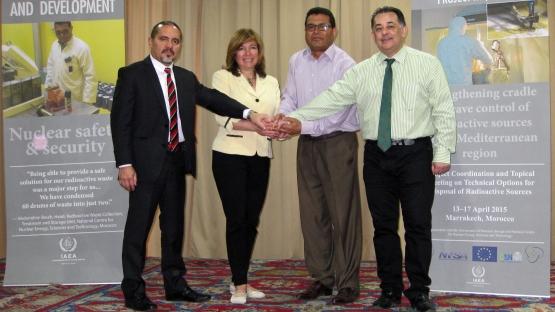Some 40 experts in radioactive sources management representing regulatory bodies, waste operators and policymakers have met in Marrakesh, Morocco, between 13 and 17 April 2015 to evaluate progress made in the Mediterranean region toward ensuring the safe and comprehensive control of radioactive sources, and to discuss how to make these achievements sustainable and available to Member States in other parts of the world.
Around the globe, radioactive sources are routinely deployed by experts in the medical, industrial and agricultural fields, to great benefit. Due to the potentially harmful effects of ionizing radiation, however, measures must be taken to ensure that radioactive sources are effectively controlled throughout their entire lifecycle-from their so-called 'birth' in research reactors and other facilities to their eventual conditioning and final disposal.
The Mediterranean region is the location of a particularly large volume of international and interregional trade, much of which involves radioactive sources or contaminated materials. In order to protect the public, and to minimize incidents involving poorly- or non-regulated radioactive sources, it is essential that Member States adopt a holistic, cradle-to-grave management approach.
In connection with an ongoing, interregional technical cooperation (TC) project which aims to strengthen cradle-to-grave controls in the Mediterranean region, the IAEA has organized a meeting in collaboration with the Government of Morocco's National Centre for Nuclear Energy, Sciences and Technology (CNESTEN) and with the cooperation of strategic project partners (namely, the European Commission, the US Department of Energy and US Nuclear Regulatory Commission, and the Spanish Nuclear Safety Council) to take stock of the outstanding achievements made with the support of the project in the years 2012 through 2015. With their eyes fixed on the future use of radioactive sources, the participants explored how to fill gaps and address existing challenges to ensure safety and security throughout the entire lifecycle of radioactive sources from cradle to grave, including technological options for disposal. Another objective of the meeting was to further the design of a new project proposal for the next TC cycle that would be open to countries currently endeavouring to put in place a comprehensive system to control radioactive sources.
"I am fully aware of the big responsibility that I take accepting the coordination role of the proposed project; however, Morocco has benefitted a lot from the achievements of the current project and I stand ready to do my bit to make sure that the tree that we started to grow in 2012 will continue producing relevant results and products for the benefits of all Member States" said Mr. Bouih, Head of the Collection, Treatment and Storage of Radioactive Waste Unit in CNESTEN and author of the project proposal.
"This project has pioneered the introduction of innovative approaches to outreach stakeholders and the public. Communication upgrades the perception of the players at national and interregional scales, generates momentum and helps build a stronger sense of community and ownership among counterparts, enhances cooperation with partners and helps identify synergies with other programmes and creates an identity of the project", said Manolo Recio, the IAEA Project Management Officer of the Mediterranean project, in his presentation on the first day of the meeting.
The second day of the meeting was devoted to the experiences of the 21 participating Member States in attendance. Participants delivered national presentations highlighting the achievements, challenges, outstanding short and medium term needs and priorities to be addressed under the follow-on project. This information was essential to validate the logical framework and work plan of the new project proposal tabled by Morocco and to correct it where necessary.
Beginning on 15 April, the technical part of the meeting focused on discussing long-term management options for radioactive sources, recovery of orphan sources, and the preparation of safety cases and safety assessments to support the licensing of storage and disposal systems. A session of the meeting was devoted to the Borehole Disposal Concept (BDC), a disposal system developed by the IAEA which offers the prospect of economic yet safe and secure disposal on a small scale. The comparative ease of site characterization and borehole construction makes this method of disposal particularly suitable for States that have limited amounts of waste, in particular disused sealed radioactive sources.
By aligning best practices, sharing knowledge, and incorporating new technologies, the participating Member States are already establishing a firm foundation for cradle-to-grave management of radioactive sources, in the Mediterranean region and beyond. In tandem with the European Union, national stakeholders, and other partners, the IAEA will continue to support this management practice worldwide.




